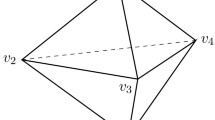Abstract
Chow and Luo [3] showed in 2003 that the combinatorial analogue of the Hamilton Ricci flow on surfaces converges under certain conditions to Thruston’s circle packing metric of constant curvature. The combinatorial setting includes weights defined for edges of a triangulation. A crucial assumption in [3] was that the weights are nonnegative. Recently we have shown that the same statement on convergence can be proved under a weaker condition: some weights can be negative and should satisfy certain inequalities [4].
On the other hand, for weights not satisfying conditions of Chow — Luo’s theorem we observed in numerical simulation a degeneration of the metric with certain regular behaviour patterns [5]. In this note we introduce degenerate circle packing metrics, and under weakened conditions on weights we prove that under certain assumptions for any initial metric an analogue of the combinatorial Ricci flow has a unique limit metric with a constant curvature outside of singularities.
Similar content being viewed by others
References
Hamilton, R. S., The Ricci Flow on Surfaces, in Mathematics and General Relativity: Proc. of the AMS-IMS-SIAM Joint Summer Research Conference in the Mathematical Sciences on Mathematics in General Relativity (Santa Cruz, Calif., 1986), J. A. Isenberg (Ed.), Contemp. Math., vol. 71, Providence, R.I.: AMS, 1988, pp. 237–262.
Chow, B., The Ricci Flow on the 2-Sphere, J. Differential Geom., 1991, vol. 33, no. 2, pp. 325–334.
Chow, B. and Luo, F., Combinatorial Ricci Flows on Surfaces, J. Differential Geom., 2003, vol. 63, no. 1, pp. 97–129.
Pepa, R. Yu. and Popelensky, Th. Yu., On Convergence of Combinatorial Ricci Flow on Surfaces with Negative Weights, Lobachevskii J. Math., 2017, vol. 38, no. 6, pp. 1061–1068.
Pepa, R. Yu. and Popelensky, Th. Yu., Equilibrium for a Combinatorial Ricci Flow with Generalized Weights on a Tetrahedron, Regul. Chaotic Dyn., 2017, vol. 22, no. 5, pp. 566–578.
Thurston, W., Geometry and Topology of Three-Manifolds, http://www.msri.org/publications/books/gt3m/ (2002).
Zhou, Z., Circle Patterns with Obtuse Exterior Intersection Angles, arXiv:1703.01768 (2017).
Xu, X., Rigidity of Inversive Distance Circle Packings Revisited, Adv. Math., 2018, vol. 332, pp. 476–509.
Acknowledgments
The authors are grateful to the anonimous referee for carefully checking the manuscript.
The authors thanks A.A. Oshemkov for valuable discussions and for the following remark which unifies both the Euclidean and the hyperbolic cases of Lemma 5 for a degenerate face.
First of all, note that by the sine theorem equality (2.8) can be written as \({\textstyle{{\partial {\theta _k}} \over {\partial {r_j}}}}{\rm{sin}}{\theta _k} = {\textstyle{{\partial {\theta _j}} \over {\partial {r_k}}}}{\rm{sin}}{\theta _j}\) for both the Euclidean and the hyperbolic geometries. Using the notation from the proof of Lemma 5, denote by xi, xj, xk the lengths of the edges opposite to the vertices Ai, Aj, Ak of a triangle ΔAiAjAk, respectively. Assume that the angle θi is fixed. Then by an elementary geometry argument one can show that \({\textstyle{{\partial {x_i}} \over {\partial {x_k}}}} = {\rm{cos}}{\theta _j}\) in both the Euclidean and the hyperbolic cases. For example, one can consider the right-angled triangle ΔAkAjH, where H is the point on the geodesic line AiAj such that the geodesic line AkH is perpendicular to AiAj.
In our setting \({x_i} = {l_{jk}},{x_j} = {r_k},{x_k} = {r_j}\), and \({\textstyle{{\partial {l_{jk}}} \over {\partial {r_j}}}} = {\rm{cos}}{\theta _j}\). Therefore, \({\textstyle{{{\partial^2}{l_{jk}}} \over {\partial {r_k}\partial {r_j}}}} = - {\rm{sin}}{\theta _j} \cdot {\textstyle{{\partial {\theta _j}} \over {\partial {r_k}}}}\). Then finally from the Mixed Derivative Theorem we find that this is equal to \({\textstyle{{{\partial ^2}{l_{jk}}} \over {\partial {r_j}\partial {r_k}}}} = - {\rm{sin}}{\theta _k} \cdot {\textstyle{{\partial {\theta _k}} \over {\partial {r_j}}}}\).
Author information
Authors and Affiliations
Corresponding authors
Rights and permissions
About this article
Cite this article
Pepa, R.Y., Popelensky, T.Y. Combinatorial Ricci Flow for Degenerate Circle Packing Metrics. Regul. Chaot. Dyn. 24, 298–311 (2019). https://doi.org/10.1134/S1560354719030043
Received:
Revised:
Accepted:
Published:
Issue Date:
DOI: https://doi.org/10.1134/S1560354719030043



